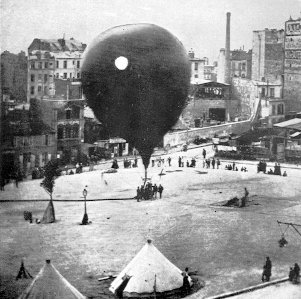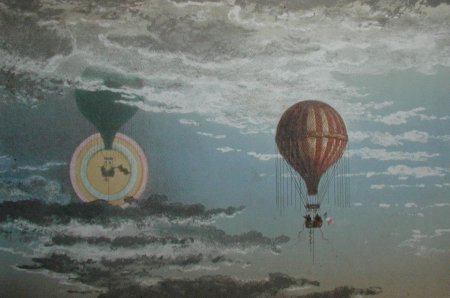Necessity in the Siege of Paris
Today, necessity, invention, and the Siege of Paris. The University of Houston's College of Engineering presents this series about the machines that make our civilization run, and the people whose ingenuity created them.
So is necessity the mother of invention? The four-month Prussian siege of Paris in 1870 offers some clues. Telegraph lines had been cut, and Paris couldn't communicate with the rest of the world. Necessity demanded a solution.
Parisians wished they could fly over the enemy's lines. In fact, two usable forms of flight did exist: carrier pigeons and balloons. Balloons could get out, but where they went was uncontrollable and only vaguely predictable. And there was no way to guide a balloon into Paris from outside. Carrier pigeons couldn't be sent anywhere; they could only find their way back to Paris.
The obvious trick was to fly both messages and crated pigeons out of Paris in balloons by night, and to send microfilmed messages back by carrier pigeon. Several pigeons had to be sent with duplicate messages because enemy soldiers shot as many as they could.
In 1871, James Glaisher added that story to the second edition of his book about ballooning, Travels in the Air. The situation in Paris fairly screamed for creative invention, but Glaisher is quite explicit in saying there was no time for that. He says,
... there was no time to originate fresh constructions or introduce new principles. The old invention as it stood was to be stimulated into success, if success were to be had.
So Parisians went to work. They set out to build balloons the same way they'd always built sporting balloons. The Post Office commandeered two train stations for factories, while trains stood idle. Precious silk was the fabric of choice for balloons, but for mass production they had to use calico. To make the cloth airtight they painted it with linseed oil and lead oxide.
The Northern Station had the new sewing machines. Workers at the Orleans station had to stitch the gasbags together by hand. Landlocked sailors went to work painting, varnishing, twisting cables, and then flying the finished balloons. They thrived on the work. It was like being back amongst the sails on their ships.
The balloons were filled with coal gas. That was a mix of light gases -- not as light as hydrogen, which was hard to come by, but lighter than hot air. And a coal-gas-filled balloon didn't need a reheating flame that would attract enemy fire.
From September through January, sixty-two one-way flights left Paris. It was old technology, serving grave necessity -- a heroic effort. But it left behind all kinds of new questions about flight.
Glaisher finishes by looking at the claim that progress and invention spring from the exigencies of war. He concludes that it's very far from being universally true.
Necessity had been a mother all right, but not of invention. Her real children were the focus, determination, and action that held Prussia at bay until an armistice could be signed.
I'm John Lienhard, at the University of Houston, where we're interested in the way inventive minds work.
(Theme music)
Glaisher, J, Flammarion, C., de Fonvielle, W., and Tissandier, G., Travels in the Air. 2nd and revised ed. London: Richard Bentley & Son, 1871. See especially the Preface to the Second edition.
For more on balloons in the siege of Paris, see Episode 1132.
I am grateful to Margaret Culbertson, UH Art and Architecture Library, for bringing the Glaisher book to my attention and for making it available to me.

Early photo of the first balloon leaving Paris during the siege

Frontispiece of the Glaisher book: Mirage and Luminous Aureola